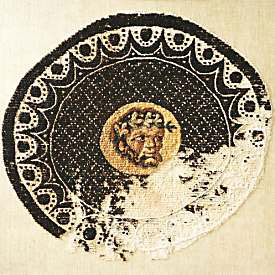1995 Early Christian Art
From mid December 1995
Early Christian Art
New acquisitions and collection
In this part of the world, evidence of early Christianity is rare. One looks in vain for shining gold mosaics and hidden paintings in catacombs. Book illustrations and ivory carvings are preserved only in few museums and some few libraries which are not easily accessible. Textiles of the late Antique Copts, the Egyptian Christians, though, are a popular field of collecting. The vestments with which the dead were buried have survived for centuries in the desert sand. Thus heathen gods and personifications have become part of the early Christian pictorial language. These depictions still adhered to the illusionist style in the 4th century; later, under the influence of Islam, they became more and more abstract. Genuinely Christian topics are rare – these only develop elsewhere in other fields of art. At the very beginning, there are mosaics from the time of Constantine in the holy places of Christianity. As a reflection of these few “monumental paintings” that are not well preserved, we find little lead ampullae which made their way into the West mostly in the 6th century as devotional objects for pilgrims. These ampullae, filled with oil which contained a healing character because they came into touch with the places of devotion, represent on their part lost compositions; here, for example, the Mother of God with two angels. A papyrus dating from late Antiquity shows the hetoimasia, the throne being prepared for the god not yet exalted – a depiction which also stands at the beginning of Christian imagery. Embedded into the old, now restored collection, the new acquisitions, to be introduced in a changing display in the future, provide insight into the birth of a new imagery which continues up to the present.
Early Christian Art
New acquisitions and collection
In this part of the world, evidence of early Christianity is rare. One looks in vain for shining gold mosaics and hidden paintings in catacombs. Book illustrations and ivory carvings are preserved only in few museums and some few libraries which are not easily accessible. Textiles of the late Antique Copts, the Egyptian Christians, though, are a popular field of collecting. The vestments with which the dead were buried have survived for centuries in the desert sand. Thus heathen gods and personifications have become part of the early Christian pictorial language. These depictions still adhered to the illusionist style in the 4th century; later, under the influence of Islam, they became more and more abstract. Genuinely Christian topics are rare – these only develop elsewhere in other fields of art. At the very beginning, there are mosaics from the time of Constantine in the holy places of Christianity. As a reflection of these few “monumental paintings” that are not well preserved, we find little lead ampullae which made their way into the West mostly in the 6th century as devotional objects for pilgrims. These ampullae, filled with oil which contained a healing character because they came into touch with the places of devotion, represent on their part lost compositions; here, for example, the Mother of God with two angels. A papyrus dating from late Antiquity shows the hetoimasia, the throne being prepared for the god not yet exalted – a depiction which also stands at the beginning of Christian imagery. Embedded into the old, now restored collection, the new acquisitions, to be introduced in a changing display in the future, provide insight into the birth of a new imagery which continues up to the present.
